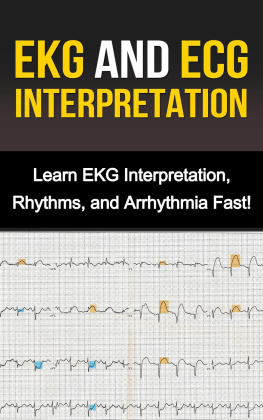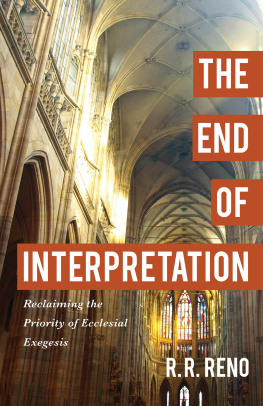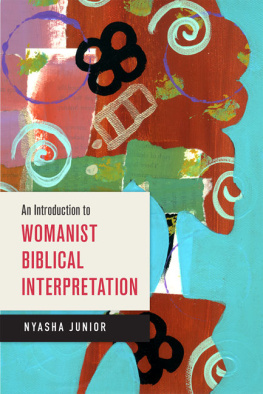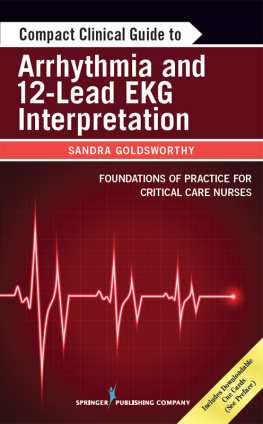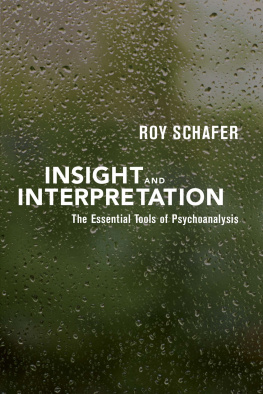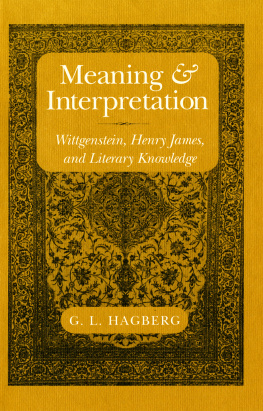Alyssa Stone - EKG and ECG Interpretation: Learn EKG Interpretation, Rhythms, and Arrhythmia Fast!
Here you can read online Alyssa Stone - EKG and ECG Interpretation: Learn EKG Interpretation, Rhythms, and Arrhythmia Fast! full text of the book (entire story) in english for free. Download pdf and epub, get meaning, cover and reviews about this ebook. year: 2020, publisher: Ingram Publishing, genre: Children. Description of the work, (preface) as well as reviews are available. Best literature library LitArk.com created for fans of good reading and offers a wide selection of genres:
Romance novel
Science fiction
Adventure
Detective
Science
History
Home and family
Prose
Art
Politics
Computer
Non-fiction
Religion
Business
Children
Humor
Choose a favorite category and find really read worthwhile books. Enjoy immersion in the world of imagination, feel the emotions of the characters or learn something new for yourself, make an fascinating discovery.
- Book:EKG and ECG Interpretation: Learn EKG Interpretation, Rhythms, and Arrhythmia Fast!
- Author:
- Publisher:Ingram Publishing
- Genre:
- Year:2020
- Rating:4 / 5
- Favourites:Add to favourites
- Your mark:
- 80
- 1
- 2
- 3
- 4
- 5
EKG and ECG Interpretation: Learn EKG Interpretation, Rhythms, and Arrhythmia Fast!: summary, description and annotation
We offer to read an annotation, description, summary or preface (depends on what the author of the book "EKG and ECG Interpretation: Learn EKG Interpretation, Rhythms, and Arrhythmia Fast!" wrote himself). If you haven't found the necessary information about the book — write in the comments, we will try to find it.
Alyssa Stone: author's other books
Who wrote EKG and ECG Interpretation: Learn EKG Interpretation, Rhythms, and Arrhythmia Fast!? Find out the surname, the name of the author of the book and a list of all author's works by series.
EKG and ECG Interpretation: Learn EKG Interpretation, Rhythms, and Arrhythmia Fast! — read online for free the complete book (whole text) full work
Below is the text of the book, divided by pages. System saving the place of the last page read, allows you to conveniently read the book "EKG and ECG Interpretation: Learn EKG Interpretation, Rhythms, and Arrhythmia Fast!" online for free, without having to search again every time where you left off. Put a bookmark, and you can go to the page where you finished reading at any time.
Font size:
Interval:
Bookmark:
EKG and ECG Interpretation
Learn EKG Interpretation, Rhythms, and Arrhythmia Fast!
 |  |


T able Of Contents
Introduction
Chapter 1 - The Basics Of EKG/ECG
Chapter 2 - Electrocardiogram: Uses, Procedure and Types
Chapter 3 - Electrocardiogram: Basic Analysis and Interpretation of Rhythm and Rate
Chapter 4 - ECG Interpretation For Waves and Intervals
Chapter 5 - Irregular ECG Readings: Arrhythmias
Chapter 6 - Tips For A Healthy Heart: No To Arrhythmias
Conclusion
Introduction
I want to thank you and congratulate you for downloading the book, EKG and ECG Interpretation.
This book contains helpful information about ECG interpretation, and how to interpret a range of different heartbeats and rhythms.
You will discover exactly what ECG interpretation is, how it is conducted, and the equipment required. You will learn about the different types of ECG, and how each one is performed and recorded.
Youll be shown how to read an ECG graph, and determine if a heartbeat is regular or not. This includes determining different ailments, heart rate, rhythm, and looking out for arrhythmias.
This book will provide you the steps and strategies required to successfully understand and interpret the different heart rhythms, and determine if your heart is functioning properly!
Thanks again for downloading this book, I hope you enjoy it!
Chapter 1 The Basics of EKG/ECG
Electrocardiogram (ECG) is a combination of three words electro, cardio, and gram, which mean electricity, heart, and recording, respectively. Simply put, it is a recording of the electrical activity of the heart. ECG is a non-invasive diagnostic procedure that can help determine the condition of the heart to a certain degree. It is also known as EKG because of the Greek word kardia for heart.
Review of the Cardiovascular System
To understand ECG better and the steps in interpreting it, a review of the anatomy and physiology of the heart is important. Here it is:
The heart is a muscular organ made up of four chambers, two atria (right and left) and two ventricles (right and left). Its size is estimated to be that of the size of a persons closed fist. It acts as the pump to circulate oxygenated blood from the heart to the vital organs first, then to the remaining parts of the body. Together with the lungs and vascular system, the heart works to turn deoxygenated (oxygen deprived) blood to oxygenated blood for distribution around the body.
Blood Flow through the Heart
It is also important to know how blood flows through the heart into all body parts. Starting on the hearts right upper chamber called the right atrium, the deoxygenated blood from the upper extremities and head will enter the heart via the superior vena cava. The blood coming from the lower parts of the body would enter the right atrium through the inferior vena cava. Oxygen deprived blood from the heart itself will go back to the heart via the coronary sinus.
From the right atrium, blood would pass through the tricuspid valve going to the right ventricle. The tricuspid prevents the backflow of blood from ventricle to atrium, as blood flow is unidirectional or flows in one direction only. From the right ventricle, blood will pass through the pulmonary artery, which is the only artery that carries deoxygenated blood. It would go to the lungs where gas exchange takes place. In here, the release of carbon dioxide and the absorption of oxygen will take place, making the deoxygenated blood become oxygenated blood.
The oxygenated blood will go back to the heart through the pulmonary vein, which is the only vein that carries oxygenated blood, to the left atrium. Then it will pass through the bicuspid valve to go to the left ventricle. Just like the tricuspid valve, the bicuspid valve will prevent the backflow of the blood. From the left ventricle, it would pass through the semilunar aortic valve, aorta and then to the systemic circulation. This cycle would then be repeated.
Your heart pumps around 5-6 liters of blood per minute, totaling to 7200-7500 liters throughout a whole day. The normal average heartbeat for adults is about 80-100 per minute.
With this knowledge, it will be easier to understand the conduction system or the electrical activity of the heart, which is the main purpose of ECG.
Understanding the Conduction System
The conduction system is why your heart pumps. How does this happen? Just like a regular pump machine that needs a power source and electricity for it to run, the heart needs electricity, too. The difference is that the heart is able to create the electrical impulses that it needs and controls the impulses through a specialized conduction pathway.
This conduction pathway is composed of the following:
The Sino-atrial node or SA node
The Atrio-ventricular node or AV node
The bundle of His
The left and right bundle
The Purkinje fibers
The SA node is known as the pacemaker of the heart as it is the one that initiates the impulse. From the SA node, the electric impulse will travel up to the AV node. From the AV node, the impulse will pass to the bundle of His. It will continue downward to the left and right bundles. Finally, the last destination of the impulse is at the Purkinje fibers. This is equivalent to one rhythmic heartbeat.
In a normal person, this will occur 80-100 times per minute. In case the SA node fails to transmit an impulse, the AV node will take over. However, it can only do as many as 40 to 60 impulses, giving 40-60 beats per minute (bpm). Again, if the AV node fails, the survival instinct of the body will take over and the bundle of His will take over. It can generate up to 20 t0 40 impulses only. Still, if that fails, the Purkinje fiber will take the role of the SA node, but its capacity is only 0-20 impulses.
The purpose of ECG
This is where ECG comes in. As the impulses will initiate the rhythmic beat of the heart, any deviation from what this system normally does can affect the whole body. Hence, it is very important to assess the condition of the conduction system, especially to those with existing cardiovascular disorders.
Chapter 2 - Electrocardiogram: Uses, Procedure and Types
ECG or EKG is a painless diagnostic exam that is helpful in determining any abnormality of the structure, function and rhythm of the heart.
Uses of ECG
The doctor may order ECG to determine the following:
The condition of the conduction system or electrical activity of the heart
The rate of the heart
The rhythm of the heart
The presence of ischemia (poor blood flow)
The occurrence of a heart attack
The cause of a chest pain
Hypertrophy or enlargement of the chambers of the heart
Other structural deviations such as obstructions, holes, thickening of lining or stenosis (narrowing) of valves, to name a few
Aside from these, the doctor may also order ECG for the following reasons:
For complaints of shortness of breath, fainting, dizziness or palpitations
To determine if the cardiac medicines prescribed to a person are working
If a device, such as a pacemaker implant, is functioning well
To monitor the health of the heart of those with a family history of cardiac ailments and other medical conditions such as hypertension, diabetes, coronary artery disorders, atherosclerosis, kidney problems and others
Next pageFont size:
Interval:
Bookmark:
Similar books «EKG and ECG Interpretation: Learn EKG Interpretation, Rhythms, and Arrhythmia Fast!»
Look at similar books to EKG and ECG Interpretation: Learn EKG Interpretation, Rhythms, and Arrhythmia Fast!. We have selected literature similar in name and meaning in the hope of providing readers with more options to find new, interesting, not yet read works.
Discussion, reviews of the book EKG and ECG Interpretation: Learn EKG Interpretation, Rhythms, and Arrhythmia Fast! and just readers' own opinions. Leave your comments, write what you think about the work, its meaning or the main characters. Specify what exactly you liked and what you didn't like, and why you think so.

